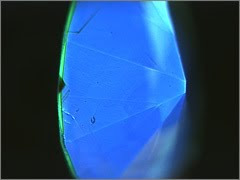Etienne's Golden Philippine saltwater Pearl necklace complemented with a gorgeous Green Colored Diamond pave interchangeable clasp is a truly breathtaking sight. No surprise it has turned many heads in the Fine Jewelry World!
Here's a copy of her post. Please follow the links to check out the Color-n-Ice blog directly!
Some Times Beauty is Only Skin Deep
All naturally colored diamonds are rare. In an ideal scenario, diamonds are formed from a single element, that being pure carbon-rendering them exquisitely colorless. Their tint can come from a variety of trace elements that intrude into the molecular structure of the mineral. But color can also result from mechanisms not fully understood. How are color-change diamonds created exactly--or pink, for that matter? The jury is still out on that mysterious transpiration.
When it comes to natural green diamonds, scientists tell us, it is the result of that diamonds' close encounter with naturally occurring subterranean radiation. Therefore with the very few green diamonds that make up the global harvest annually, many will have their green tint most present on the skin of the crystal--the very outer surface.
Green diamonds are scrutinized thoroughly in order for the cutter to best determine how to approach polishing this rarity and to conserve as much green as possible on the finished stone.
Few people have the privilege of seeing a fancy color green diamond, outside of a handful in museums around the world. The most famous green diamond that the public can view is the 41 carat Dresden Green Diamond displayed in a German museum.
Fortunately, diamond lovers can treat themselves to enhanced green diamonds which pack a punch on any jewelry item featuring them. Couture designer Etienne Perret knows just how to show off these verdant beauties with his luxurious enhanced green diamond pave clasp paired artfully to some yummy golden pearls.
When it comes to natural green diamonds, scientists tell us, it is the result of that diamonds' close encounter with naturally occurring subterranean radiation. Therefore with the very few green diamonds that make up the global harvest annually, many will have their green tint most present on the skin of the crystal--the very outer surface.
Green diamonds are scrutinized thoroughly in order for the cutter to best determine how to approach polishing this rarity and to conserve as much green as possible on the finished stone.
Few people have the privilege of seeing a fancy color green diamond, outside of a handful in museums around the world. The most famous green diamond that the public can view is the 41 carat Dresden Green Diamond displayed in a German museum.
Fortunately, diamond lovers can treat themselves to enhanced green diamonds which pack a punch on any jewelry item featuring them. Couture designer Etienne Perret knows just how to show off these verdant beauties with his luxurious enhanced green diamond pave clasp paired artfully to some yummy golden pearls.


